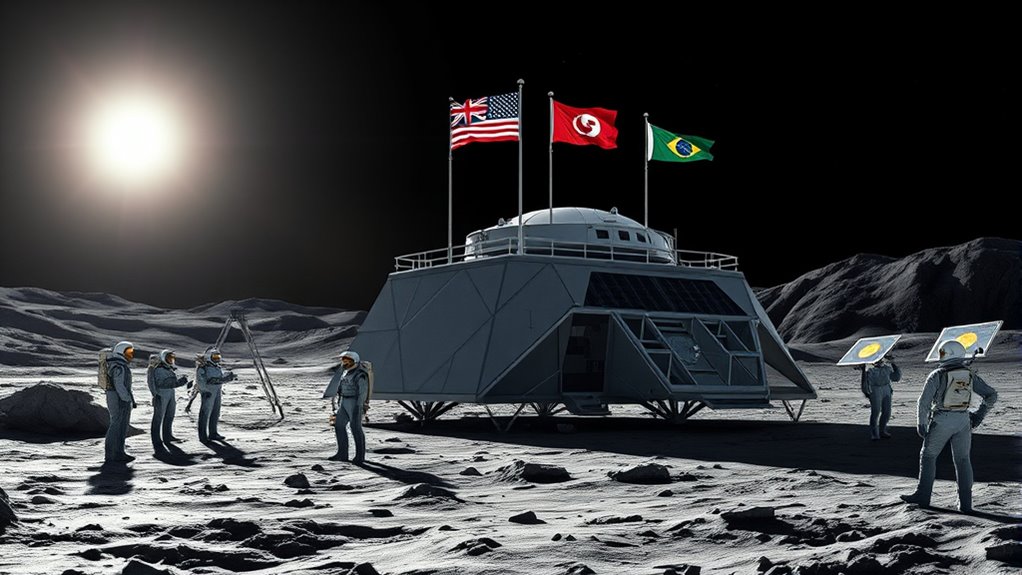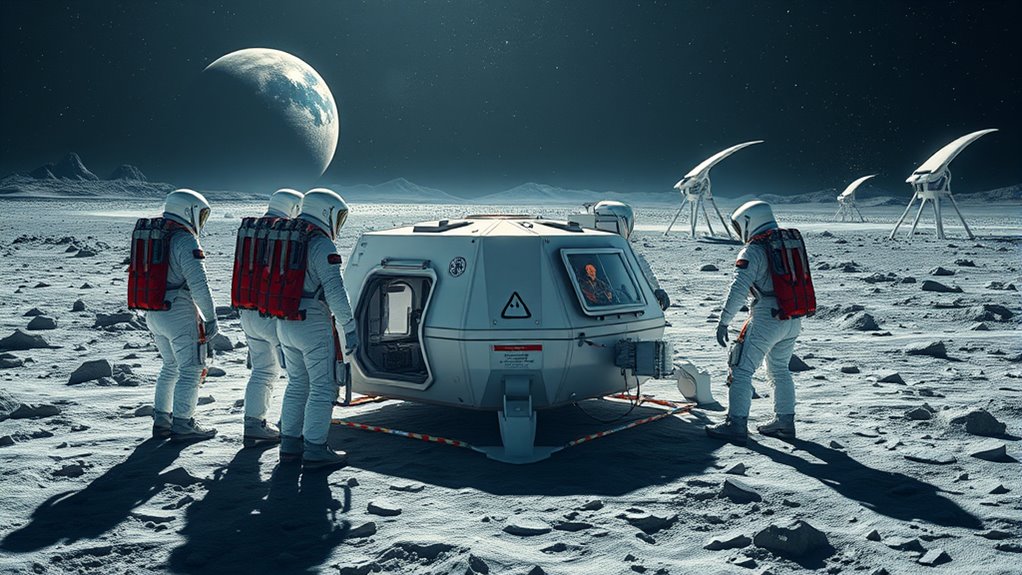An international team is actively designing a lunar habitat prototype to test by 2026, marking a key step toward establishing a sustainable moon base. This effort combines diverse expertise, focusing on creating sturdy, adaptable shelters with advanced radiation shielding and life support systems. As they coordinate across nations, overcoming technical and logistical challenges, their progress highlights global cooperation in space exploration. Keep exploring to discover how these innovations are shaping humanity’s lunar future.
Key Takeaways
- An international team is developing a lunar habitat prototype to demonstrate sustainable living systems for future moon bases.
- The prototype aims to be operational by 2026, marking a major milestone in space exploration efforts.
- Collaborative efforts involve multiple countries, agencies, and private companies sharing expertise and resources.
- The project focuses on innovative radiation shielding, life support recycling, and modular, adaptable structures.
- Advancements support the goal of establishing a functional moon base and testing technologies for long-term lunar habitation.

An international team of scientists and engineers has successfully built a prototype for a moon base, marking a significant milestone in space exploration. This achievement demonstrates the progress made in lunar habitat design, showcasing how diverse expertise converges to tackle the complexities of living on the Moon. Your role in understanding this breakthrough highlights the importance of collaborative efforts, as this project involves multiple countries, agencies, and private companies working together toward a shared goal. Designing a lunar habitat isn’t just about creating a sturdy shelter; it involves solving issues related to radiation protection, life support systems, and sustainable energy sources—all within the constraints of lunar conditions. The prototype serves as a tangible step toward testing these systems in a controlled environment before actual deployment on the Moon.
International collaboration advances lunar habitat design for a sustainable moon base by 2026.
However, you should appreciate the challenges of international collaboration that come with such an ambitious project. Different nations bring their own standards, technologies, and operational cultures, which can sometimes create friction or delays. Coordinating research and development efforts across time zones and languages demands meticulous planning and clear communication. Funding disparities and geopolitical tensions further complicate the process. Despite these hurdles, the team managed to align their objectives, sharing data and resources to develop a design that balances scientific needs with practical constraints. This cooperation exemplifies how global unity can accelerate technological progress, even when faced with logistical challenges.
As you follow the progress, recognize that the lunar habitat design has evolved from theoretical concepts into a functional prototype through iterative testing and feedback. Engineers have integrated modular structures that can be assembled on-site, adaptable interior layouts, and innovative life support systems that recycle air and water efficiently. The prototype also incorporates radiation shielding materials that protect inhabitants from harmful lunar radiation, a vital factor for long-term missions. These advancements are a direct result of international collaboration, where each partner contributes specialized knowledge—whether in materials science, robotics, or environmental control. Such synergy ensures the lunar habitat can withstand the harsh lunar environment while providing a safe, sustainable living space. Additionally, understanding the importance of mass production techniques in scaling up habitat components can significantly impact the project’s feasibility and timeline.
In essence, this prototype embodies what can be achieved when nations and organizations unite around a common purpose. You see firsthand how the challenges of lunar habitat design are being addressed through shared expertise, and how overcoming international collaboration challenges is fundamental to turning the vision of a lunar base into reality. By 2026, you’ll witness the shift from prototype to operational moon base, a testament to human ingenuity and global cooperation.
Frequently Asked Questions
What Is the Estimated Cost of the Moon Base Project?
You should know that the estimated cost of the moon base project is around $3.5 billion. The cost estimation considers materials, technology, and labor, and funding sources include government space agencies, private companies, and international collaborations. These diverse funding sources help cover the expenses, making the project feasible. Keep in mind, costs might vary as the project develops and new technologies emerge, so ongoing budget assessments are essential.
How Will the Team Address Lunar Environmental Challenges?
Like explorers facing uncharted waters, you’ll develop innovative solutions to tackle lunar dust and radiation. You’ll use advanced radiation shielding materials, much like a shielded fortress, to protect inhabitants. For lunar dust, you’ll implement sealing techniques and specialized materials to prevent contamination and damage. By combining these strategies, you’ll guarantee the team effectively addresses environmental challenges, paving the way for a sustainable lunar presence.
What Are the Safety Protocols for Team Members?
You should follow strict safety protocols to guarantee team safety during lunar operations. This includes wearing protective gear, undergoing hazard mitigation training, and adhering to emergency procedures. Regular safety drills prepare you for potential hazards like radiation or equipment failure. You’ll also monitor environmental conditions constantly, enabling quick responses to risks. By prioritizing hazard mitigation and safety measures, you help create a secure environment for everyone working on the moon base project.
Will the Moon Base Support Long-Term Human Habitation?
Yes, the moon base is designed for long-term human habitation. You’ll find that habitat sustainability is a key focus, with advanced resource management systems ensuring you have essentials like water, air, and power. The team plans to develop efficient recycling methods and renewable energy sources, so you can live comfortably and safely on the moon for extended periods. This approach aims to support your needs while minimizing environmental impact.
How Will the Project Impact International Space Cooperation?
You might think this project is just about building a moon base, but it’s also a game-changer for international collaboration. As nations unite to achieve this milestone, diplomatic implications deepen, forging stronger ties and shared goals. This bold move could open new cooperation opportunities in space exploration, inspiring trust and teamwork among countries. The stakes are high, and your involvement could shape the future of global space efforts in ways you’ve yet to imagine.
Conclusion
As you follow this incredible project, remember that building a moon base isn’t just science fiction anymore. Just like the International Space Station fostered collaboration, this moon prototype could revolutionize space exploration. Imagine yourself witnessing astronauts living on the lunar surface, conducting research, and paving the way for future missions. This bold step shows that, with teamwork and innovation, you could be part of humanity’s next giant leap—making the moon a new frontier for all of us.








